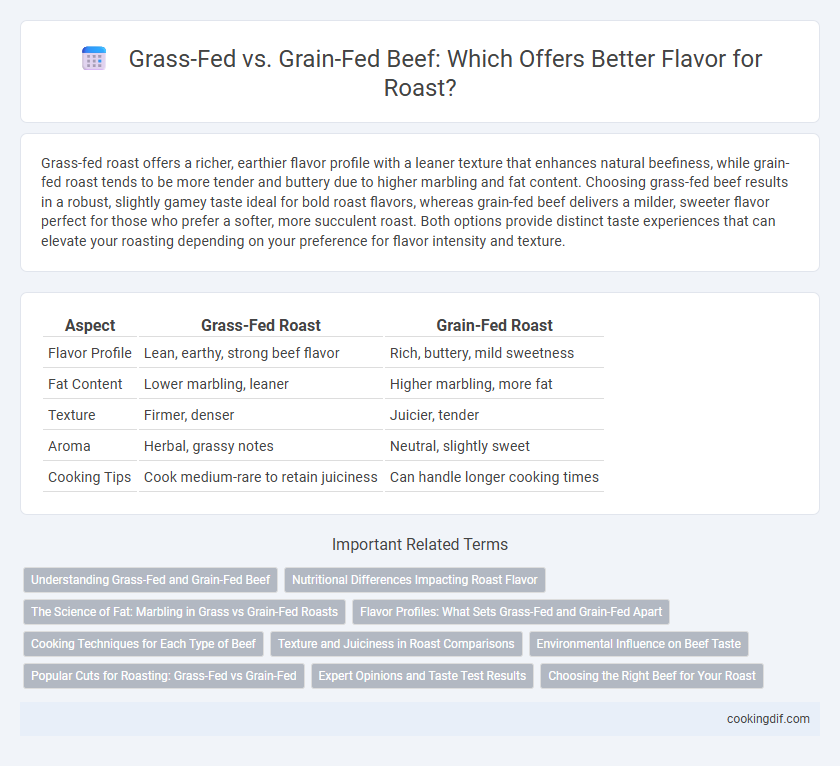Grass-fed roast offers a richer, earthier flavor profile with a leaner texture that enhances natural beefiness, while grain-fed roast tends to be more tender and buttery due to higher marbling and fat content. Choosing grass-fed beef results in a robust, slightly gamey taste ideal for bold roast flavors, whereas grain-fed beef delivers a milder, sweeter flavor perfect for those who prefer a softer, more succulent roast. Both options provide distinct taste experiences that can elevate your roasting depending on your preference for flavor intensity and texture.
Table of Comparison
| Aspect | Grass-Fed Roast | Grain-Fed Roast |
|---|---|---|
| Flavor Profile | Lean, earthy, strong beef flavor | Rich, buttery, mild sweetness |
| Fat Content | Lower marbling, leaner | Higher marbling, more fat |
| Texture | Firmer, denser | Juicier, tender |
| Aroma | Herbal, grassy notes | Neutral, slightly sweet |
| Cooking Tips | Cook medium-rare to retain juiciness | Can handle longer cooking times |
Understanding Grass-Fed and Grain-Fed Beef
Grass-fed beef offers a distinct, earthy flavor profile due to the animal's natural diet of grasses and forage, which also results in leaner meat with higher omega-3 fatty acids and antioxidants. Grain-fed beef, typically raised on corn or soy-based diets, provides a richer, more marbled texture with buttery tenderness, enhancing the roast's juiciness and overall flavor. Understanding these differences helps chefs and consumers select beef that aligns with desired taste, nutrition, and cooking methods for optimal roast results.
Nutritional Differences Impacting Roast Flavor
Grass-fed beef contains higher levels of omega-3 fatty acids and conjugated linoleic acid (CLA), which contribute to a richer, more complex roast flavor and a leaner texture. Grain-fed beef typically has more marbling due to higher intramuscular fat, resulting in a sweeter, buttery flavor and tender roast. These nutritional differences influence the Maillard reaction during roasting, enhancing distinct taste profiles based on fatty acid composition.
The Science of Fat: Marbling in Grass vs Grain-Fed Roasts
Marbling refers to the intramuscular fat that significantly influences roast flavor and tenderness, with grain-fed beef typically exhibiting higher marbling due to a high-energy diet rich in grains. Grass-fed roasts usually have leaner profiles with less intramuscular fat but contain higher levels of omega-3 fatty acids and antioxidants, which impact flavor complexity and nutritional value. The science of fat reveals that marbling enhances juiciness and mouthfeel, making grain-fed roasts more flavorful and tender, while grass-fed roasts offer a distinct, robust taste profile associated with their unique fatty acid composition.
Flavor Profiles: What Sets Grass-Fed and Grain-Fed Apart
Grass-fed roasts exhibit a robust, earthy flavor with subtle herbaceous notes, attributed to the cow's natural diet rich in diverse grasses and plants. Grain-fed roasts offer a richer, buttery taste and enhanced marbling, resulting in a tender texture and slightly sweeter profile due to high-energy corn or barley feeding. The distinct fatty acid composition in grass-fed beef promotes a leaner, more complex flavor, while grain-fed beef emphasizes softness and mild umami richness.
Cooking Techniques for Each Type of Beef
Grass-fed beef requires lower and slower cooking techniques such as slow roasting or braising to enhance its lean texture and bring out its natural, earthy flavors. Grain-fed beef benefits from higher-heat methods like roasting at elevated temperatures or searing to capitalize on its marbled fat content and develop rich, buttery flavors. Adjusting cooking time and temperature based on beef type ensures optimal tenderness and flavor development in any roast.
Texture and Juiciness in Roast Comparisons
Grass-fed beef roasts typically offer a firmer texture and a leaner profile, resulting in a slightly chewier bite compared to grain-fed varieties. Grain-fed roasts are generally more marbled, enhancing juiciness and providing a tender mouthfeel that many consumers prefer. Texture and juiciness in roast comparisons are heavily influenced by the animal's diet, with grain feeding promoting intramuscular fat that enriches flavor and moisture retention during cooking.
Environmental Influence on Beef Taste
Grass-fed beef develops a distinct, richer flavor profile influenced by diverse forage and natural grazing, which enhances its earthy and herbaceous taste. Grain-fed beef offers a milder, buttery flavor due to a diet high in corn and grains, promoting marbling that contributes to tenderness and juiciness. Environmental factors such as soil quality, pasture biodiversity, and climate directly affect the nutritional content of the feed, thereby shaping the aroma and flavor complexity of the roast.
Popular Cuts for Roasting: Grass-Fed vs Grain-Fed
Grass-fed beef offers a more robust, earthy flavor ideal for roasting popular cuts like ribeye, sirloin, and chuck, providing a leaner texture with a slightly gamey taste. Grain-fed beef, favored for prime cuts such as ribeye, strip loin, and brisket, delivers a richer, buttery flavor and more marbling, resulting in juicier and more tender roasts. Choosing between grass-fed and grain-fed for roasting depends on flavor preference and desired fat content in cuts like top round and prime rib.
Expert Opinions and Taste Test Results
Experts consistently highlight that grass-fed roast offers a more robust, earthy flavor profile, attributed to the animal's natural diet and higher omega-3 fatty acid content. Taste tests reveal grain-fed roast tends to be more tender and buttery, with a milder, sweeter flavor due to increased marbling and fat deposition. Consumer preference often splits, with grass-fed favored for its complexity and grain-fed praised for its juiciness and tenderness.
Choosing the Right Beef for Your Roast
Grass-fed beef offers a more robust, earthy flavor with leaner meat and a higher concentration of omega-3 fatty acids, making it ideal for those seeking a natural, health-conscious roast. Grain-fed beef provides a richer, buttery taste due to increased marbling and fat content, resulting in a tender, juicy roast perfect for traditional palates. Selecting between grass-fed and grain-fed beef depends on desired roast texture, flavor intensity, and nutritional preferences.
Grass-fed vs Grain-fed for roast flavor Infographic

 cookingdif.com
cookingdif.com